Portable propane heaters are by far the most popular choices for keeping your camper warm in the winter. Portable electric heaters are very effective, but require lots of electricity. You can even get a wood burning stove for your RV. The heater that runs off of your vehicle’s engine is also very effective, but not very fuel-efficient.
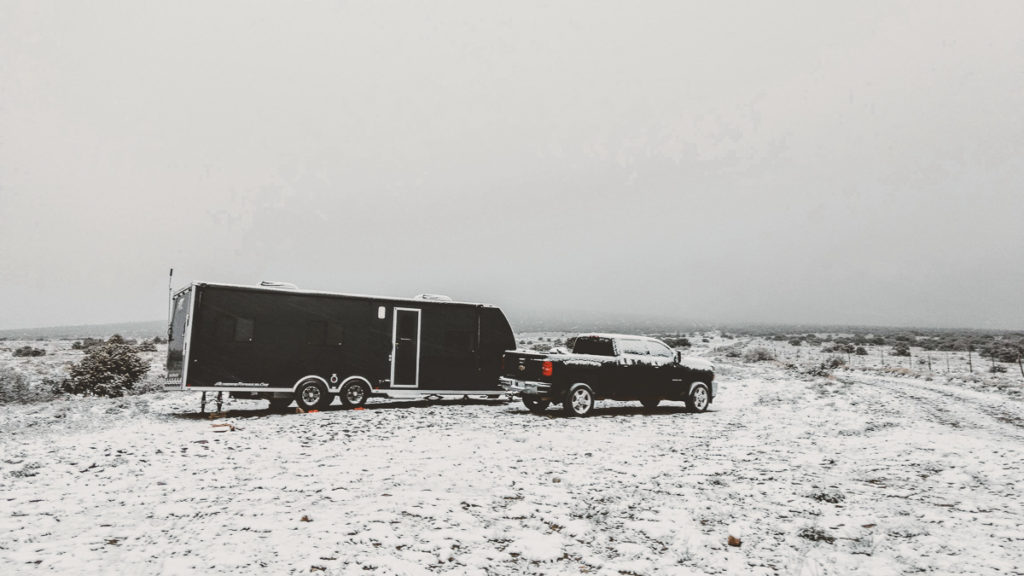
How Do I Keep My Camper Warm in the Winter?
Portable Propane Heaters
Portable propane heaters are popular because because they don’t require any electricity to operate, and because propane packs in a lot of energy for the price. The drawback is that burning propane creates tiny droplets of water in the air. Eventually they will condense together to form puddles of water on your floor. If you plan to rely on a propane heater (which most boondockers do), you will need a strategy to stay dry.
You can purchase a 1-gallon propane bottle for $5.00 at most Walmart stores, or cheaper if you buy them in a four-pack. They’re cheaper at Walmart than Amazon. Most propane bottles will last between 4 to 10 hours in most small to medium-sized propane heaters. Many boondockers prefer using portable propane heaters because the 1-gallon bottles are disposable.
You can also use propane tanks, the most common of which is the 20 pound variety, which holds approximately 5-gallons. It’s cheaper to buy propane this way. Most RVs come with at least one 20 pound tank from the factory. To use a tank with a portable heater, you will need a hose plus a regulator. The regulator slows the pressure down so that it doesn’t blow up the heater. Some portable propane heaters already have a regulator built in.
The Most Popular Portable Propane Heaters
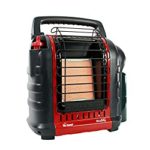
Mr. Heater Buddy, (see it on Amazon), is the most popular portable propane heater among campers. It will run for 3-4 hours on its lowest setting using a standard propane bottle. They generally sell for $80.00 to $100.00 at most stores. They produce a lot of heat, and are better suited for large vans or small RVs. This heater can also be hooked up to larger propane tanks using a separately purchased Mr. Heater Hose (see it on Amazon). This heater already has a regulator built-in for use with tanks.
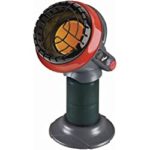
Mr. Heater Little Buddy, (see it on Amazon), will run for about 7 hours on a 1-gallon propane bottle. Perfect for car-campers, van-dwellers, and is also a popular choice for heating tents. The downside is that they tend to be easily knocked over, however they have an automatic shut-off when tipped over. While they are not intended to be hooked up to a larger propane tank via hose, they can still accommodate the Mr. Heater Hose; you just have to build your own box to keep the propane burner upright.
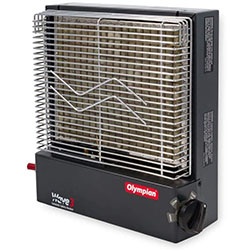
Olympian Wave Heaters, (see it on Amazon), is a type of radiant heater that works similarly to how the sun generates heat. These heaters don’t heat up air, they instead heat objects in front. If pointed at your body, you will feel a lot of heat hitting you, yet as soon as you turn it away, you will get cold. Boondockers often point this heater at their bed when sleeping. The upside is that these heaters are extremely efficient, more so than the Mr. Heater brand of heaters (mentioned above). A 5-gallon propane tank can last two to three weeks. Wave Heaters come in various sizes, from Wave-3 up to Wave-8. They do not accept propane bottles, and will only work with tanks. They do not have a regulator built-in, so you’ll have to buy a hose with a regulator attached to it. They are intended to be mounted to a wall, but you can purchase legs separately to sit on the floor.
Portable Electric Heaters
Even though most boondockers rely on propane heating, they still keep an electric heater handy. They switch over to the electric heater when they have their generator running. Once they shut off the generator, they switch back to the propane heater.
Electric heaters generally fall into three categories, ceramic heaters, fan heaters, and infrared heaters…
- Ceramic heaters are the most popular electric heaters today. They are based on the old school technology of using an electric heating coil and blowing the heated air with a fan, but they include a piece of ceramic tile. The tile absorbs the heat quickly and gets really hot. This allows the heater to produce more heat quickly than compared to a traditional fan heater.
- Fan heaters are the “old school technology” referred to above. It’s just a simple electric coil that heats up, with a fan blowing the heated air out. The only advantage they offer today is that they’re very cheap. Don’t pay more than $10.00 for this type of fan. We’ve seen them as low as $5.00 at Walmart.
- Infrared heaters send electromagnetic waves through the air that cause objects to heat up. They don’t actually heat up the air. They work best by pointing the heater at you, or at your bed when retiring for the night. Because they don’t use fans, they are absolutely silent, making them perfect for light sleepers. They more ideal for families with children or pets because they don’t get hot at all.
- All three types of heaters above use the same amount of electricity, and generate the same amount of heat. Generally, they draw 1,500 watts of power and put out between 5,000 to 5,200 BTUs of heat.
The Most Popular Electric Heaters
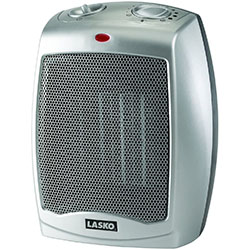
Lasko Ceramic Heater, (see it on Amazon), This is probably the most widely-purchased space heater in the United States. It’s sold at Walmart, Target, Home Depot, Amazon, and other major stores. You just plug it into a wall outlet and turn it on. You don’t have to get the Lasko brand. All brands of ceramic heaters plug into a standard wall outlet draw the same 1,500 watts at the highest setting, and produce the same 5,000-5,200 BTUs of heat. They’re cheap enough (about $30.00 to $40.00 each) that you can buy a couple of them.
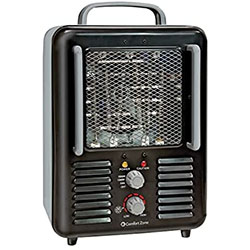
Comfort Zone Utility Heater, (see it on Amazon), This is your standard, old school, portable electric heater. They draw the same amount of power as the Lasko Ceramic Heater, and produce the same amount of heat. The only difference is they lack the ceramic plates. The end result is that they take longer to heat up a room. This brand is encased in metal, giving it a more masculine look. The advantage is that they are very cheap to buy.
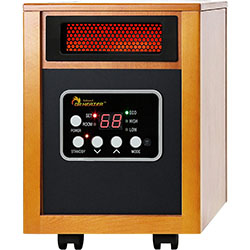
Dr. Heater Infrared Heater, (see it on Amazon), This is the most widely-purchased infrared heater in the United States. If you don’t like the wood-grain box, you can also get this in black. There are other companies that make different colors and styles. Infrared heaters such as this draw the same amount of power as the Lasko Ceramic Heater and produce the same amount of heat.
Wood Burning Stoves for RVs
Yes, they actually make wood burning stoves for RVs. These are just like the wood stoves for use in homes, but much smaller. You will need to cut a hole in your RV’s roof for the flue, but if you’re willing to do it, you can enjoy traditional-style heating in your RV.
The advantages to a wood burning stove…
- You get dry heat with no condensation forming inside your RV.
- Dead and down wood is free and plentiful when boondocking, even in many desert environments.
- Save a lot of money on fuel in not having to run a generator.
- Wood burning stoves produce far more heat than any other kind of heater.
- Most wood burning stoves designed for RVs can also double as a cook top.
The disadvantages…
- Requires a lot of installation work, cutting hole in your RV roof, adding heat shielding tile or paneling to nearby walls.
- Far more expensive than any other kind of heater.
- Once it is installed, it cannot be removed, unless you have a solution for covering the hole in the roof.
- The chimney will add another 12 to 18 inches of height to your RV’s total height.
- The chimney needs to be cleaned at least once per year.
- It can add substantial weight, which could be a problem with RVs that have low cargo carrying capacities.
The Most Popular Wood Burning Stoves for RVs
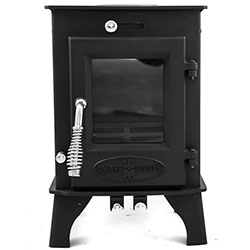
Dwarf Wood Stove, (see it on TinyWoodStove.com), offers the most traditional look, feel, and operation of a wood stove designed for RV applications. Their smallest size, the Dwarf 3kw generates 10,000 to 15,000 BTUs of heat, depending on the type of wood used. The Dwarf line of wood burning stoves are heavy, weighing about 75 pounds in its smallest size. Cost is about $800.00 for the stove itself, and additional $400.00 to $600.00 for the flue, chimney, and mounting hardware.
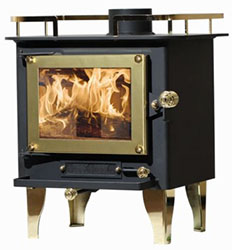
Cubic Grizzly Wood Stove, (see it on CubicMiniWoodStoves.com), producing between 8,000 to 18,000 BTUs of heat, the Cubic Grizzly weighs much less than the Dwarf Wood Stove (above) at 39 pounds. The cost is comparable at $570.00 for the stove itself, but you will want to add another $500.00 for the flue, chimney, and mounting hardware.
Ways to Insulate to Your Vehicle
Reflectix Sheeting
This is also known as “silver bubble wrap”. It’s just two very thin layers of aluminum with a thin sheet of bubble wrap in between. Most RVers use it to keep heat out of their rigs during the summer. But, it’s also keeps heat from escaping during the winter.
You can line the ceiling with Reflectix to keep heat from passing through. If you feel so inclined, add layers to your walls. Note that, some RV manufacturers already line their walls with Reflectix.
Rubber-Backed Carpeting
During the winter, the walls and floor of your RV will gather condensation, mostly due to the use of propane heating. This condensation will run down the walls and pool on the floor, ultimately getting your socks soggy.
The solution is to buy carpeting with rubber backing.
The rubber-backing will stop water from soaking through to your feet. Note that most area rugs sold in stores are glue-backed. This won’t stop water from penetrating up. You must get rubber-backed carpet.
If your RV’s floor has plywood underneath (which most RVs do), you will have to soak up that water at some point, or else mold and mildew and form.
RV Skirting
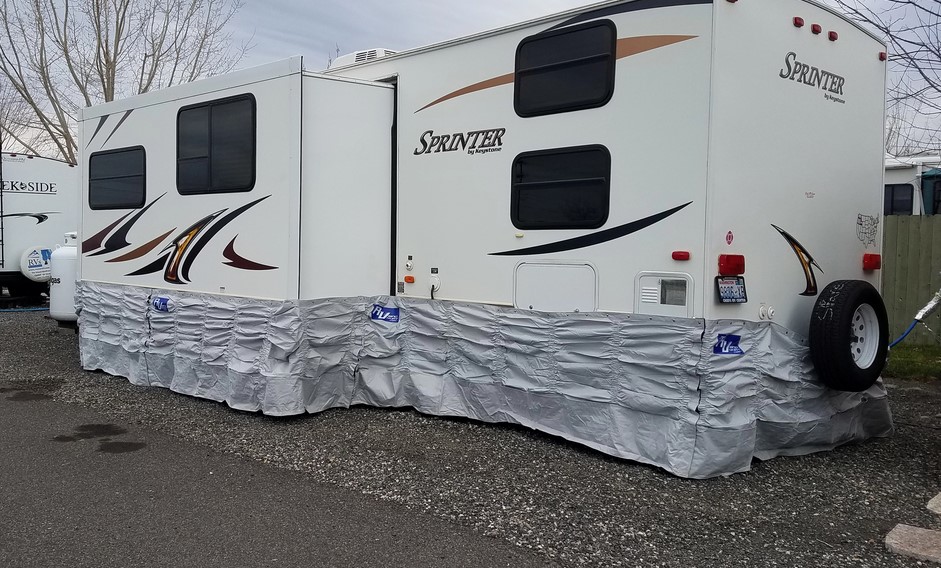
Many RVers will attach fabric panels along the bottom edge of their rigs to stop the wind from blowing underneath. When wind moves underneath the RV, it blows away all heat that has radiated from inside. When an RV is completely surrounded with skirting, that heat remains in place.
This will also prevent water lines and tanks from freezing over.
A company named “RV Windskirt” makes most of the panels sold in the United States (see it on Amazon).
Note: you don’t actually have to buy these panels. You can also line plastic storage bins all around your RV and tape trash bags in between to close off the gaps. Make sure to fill the storage bins with something to weigh them down.
Wrap Your Water Lines
The section of Pexate piping running from your water tank to inside your RV should be insulated from the weather. Most RV manufacturers leave this pipe exposed. Your water line is the most vulnerable to freezing. Meanwhile, the water tank and sewage tanks can withstand a few days of extreme cold before freezing up and bursting.
We recommend a double wrap of yellow fiberglass wrap (see it on Amazon) around the pipe, and then a second layer of rubber adhesive tape (see it on Amazon). The two combined should give your piping an insulation factor of “R3” to “R4”.
3-Season and 4-Season Plumbing
Your RV may have been outfitted with “3-season” or “4-season” plumbing. The two are effectively synonymous. There is actually no such thing as true “4-season” plumbing because there is no way to guarantee your pipes will survive the coldest winters.
However, it’s difficult to keep water lines from freezing over even if your RV comes with this feature, especially when boondocking. The reason why is because the heating pads used to heat water lines get their power from your RV’s battery bank, and they draw a lot of power over an 8-10 hour night. It’s very common for batteries to die out before the sun comes up. Instead, you will have to run your generator to make sure the batteries remain constantly charged. And even at that, the heating pads cannot withstand extreme cold temperatures (below zero F) for very long.
If you want to wrap your water lines in heating pads, Facon is one of the top brands for RV tank and pipe heaters (see them on Amazon). These heating pads are designed to only turn on when temperature drops to below 40 degrees F.
Some boondockers who choose to brave freezing weather for several weeks to months will instead place a portable electric heater (like a ceramic heater) underneath their rig, along with skirting the entire edge, to keep their water lines flowing.
For more about your water lines, read “How do I Keep My RV Water Pipes From Freezing?“
Keeping Your Batteries Warm
If you have a set of lithium phosphate batteries (like Battleborn), then you will have to create a warm space for them. Otherwise, once battery temperature drops to 32 degrees F, they will no longer recharge.
The same water line heating pad mentioned above can also be used to keep batteries from getting too cold. You just wire the pad directly to the battery. The pad will automatically turn on/off when needed.
Keeping Your Propane Warm
Yes, even propane needs to stay warm. Once outside air temperature reaches -44 degrees F, propane loses all ability to convert from liquid to gas. However, even if the temperature is above -44, it still loses pressure the closer it gets to that magic number.
But it’s really the regulator where the problem is. The tanks themselves will take a lot of freezing cold yet still produce enough vapor pressure. The regulator, however, will often seize up at 0 degrees F or less. The reason why is because water and other debris will get inside the regulator over time. To remedy this, you can just secure a fuzzy blanket around the regulator, and stick a “Hot Hands” packet inside (see it on Amazon). The Hot Hands will generate enough heat to keep the regulator working properly.
Just Move South!
Most boondockers don’t set up camp in freezing weather. They move south into the deserts of California and Arizona. Even there in the winter, it can still drop to below 32 degrees F at night, but at least it doesn’t freeze up for weeks at a time.
It’s not easy to boondock in freezing weather for several days in a row, or even for a week. You’ll get very anxious and nervous. One by one, things will start to go wrong, and you will be quickly overwhelmed. We have boondocked in snow and ice a number of times, and we don’t like to do it. It’s something you can certainly learn and master, but it’s so much more easy to just move south.
For more about boondocking in freezing temperatures, read, “Boondocking in Freezing Temperatures“.


You never answered your own question. How do you keep your RV warm in the winter?